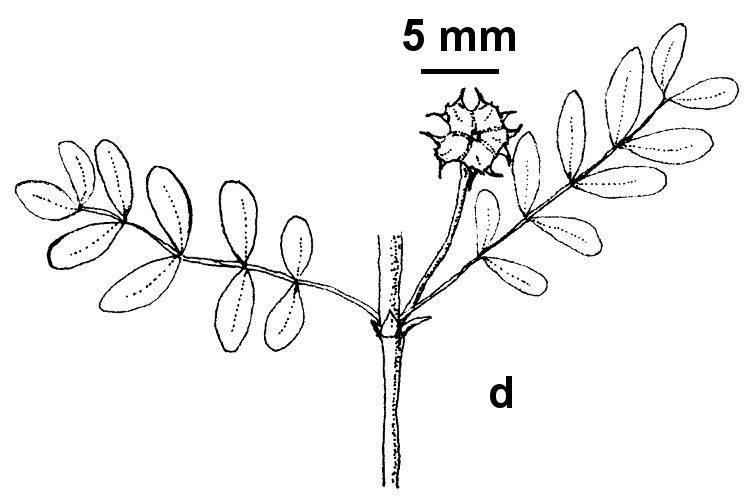Tribulus minutus
Leichh. ex Benth. CaltropProstrate much-branched annual or perennial herb; stems to 60 cm long, covered with short appressed hairs, glabrescent with age. Leaves opposite, unequal, sometimes 1 falling and then appearing alternate, with 3–7 pairs of leaflets; leaflets subsessile, obliquely oblong, 3–8 mm long, to c. 2.5 mm wide, apex acute or obtuse, upper surface with hairs mostly on midrib and margins, lower surface more evenly hairy; stipules more or less triangular, to c. 1 mm long. Flowers on pedicels to c. 10 mm long; sepals ovate, 1.5–3 mm long, acute; petals obovate, 3–5 mm long, yellow; stigma hemispherical to globose, style much shorter than stigma, often nearly absent. Schizocarp more or less globose, glabrous or with sparse broad-based bristles; mericarps pyramidal, 2–5 mm long, rugose-muricate on dorsal surface, with 2 divergent spines 0.5–2 mm long below middle and 2 very short downward pointing spines near base; seeds 1 or 2 per mericarp. Flowers mostly Nov.–Apr.
MuM. Also WA, NT, SA, Qld, NSW. Currently known in Victoria only by a few roadside collections from Irymple near Mildura.
The collecting notes on the three Victorian specimens indicate that the populations in Victoria are perennial, in constrast to the annual Tribulus terrestris. R. F. Parsons cited in Barker (1998) remarked on the fact that Victorian plants are obviously perennial on account of the massive woody rootstocks.
Jeanes, J.A. (1999). Zygophyllaceae. In: Walsh, N.G.; Entwisle, T.J., Flora of Victoria Vol. 4, Cornaceae to Asteraceae, pp. 198–207. Inkata Press, Melbourne.
 Spinning
SpinningBarker, R.M. (1998). A trial key and notes on Tribulus (Zygophyllaceae) in Australia, including one new species and validation of Tribulus suberosus. Nuytsia 12(1): 9–35.




